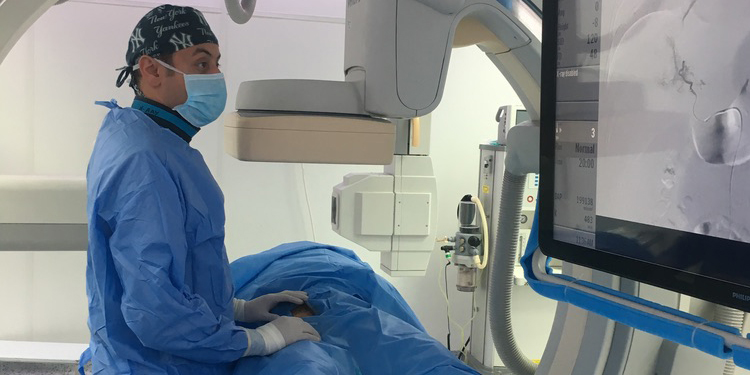
Overview
An In-depth Explanation of Uterine Fibroid Embolization (Non-operative treatment of uterine myomas)
What is Uterine Fibroid Embolization (UFE)?
Uterine Fibroid Embolization (UFE) is a non-surgical, minimally invasive procedure designed to treat non-cancerous growths in the uterus called uterine fibroids. An interventional radiologist guides a catheter to the fibroids, injecting tiny particles to block their blood supply. This induces fibroid shrinkage, alleviating symptoms like heavy menstrual bleeding and pelvic pain. UFE is a less invasive alternative to traditional surgical treatments with a shorter recovery time, often allowing women to preserve their uterus.
Types of Fibroids:
- Intramural Fibroids: Common type, grow within the muscular wall of the uterus, causing uterine enlargement.
- Subserosal Fibroids: Create a bulge and pressure on surrounding organs on the uterus's outer surface.
- Submucosal Fibroids: Develop beneath the inner lining, protruding into the uterine cavity, leading to heavy menstrual bleeding.
- Pedunculated Fibroids: Grow on a stalk inside or outside the uterus, causing symptoms based on location.
Symptoms of Uterine Fibroids:
Uterine fibroids present with varying symptoms, impacting women differently. Some common symptoms include:
- Menstrual Irregularities: Weighty and prolonged periods, longer or more frequent menstrual cycles, pelvic pressure or pain during periods.
- Urinary and Digestive Issues: Frequent urination, difficulty emptying the bladder, constipation.
- Abdominal Changes: Growing stomach area.
- Pain and Discomfort: Pain in the stomach area or lower back, discomfort during sexual intercourse.
- Serious Complications (Rare): Sudden, severe pain if fibroids outgrow their blood supply and begin to die.
When to Seek Medical Attention:
Consult a doctor if you experience persistent pelvic pain, heavy or painful periods affecting daily activities, spotting or bleeding between periods, difficulty emptying the bladder, ongoing fatigue and weakness (potential signs of anemia).
Uterine Fibroids Treatments: Uterine Fibroid Embolization (UFE)
Procedure Overview:
Uterine Fibroid Embolization (UFE) is a non-surgical treatment that shrinks fibroids by obstructing their blood supply. Interventional radiologists use imaging technology and a thin catheter to inject small particles into the arteries supplying blood to the uterus, causing fibroids to shrink or die. The procedure, lasting less than an hour, involves a small incision in the femoral artery and can be performed on an outpatient basis or with a one-night hospital stay.
Benefits of Uterine Fibroid Embolization:
UFE offers numerous benefits for those with severe uterine fibroid symptoms, including preservation of the uterus, reduction in heavy menstrual bleeding, decrease in urinary dysfunction, alleviation of pelvic pain and/or pressure, minimal blood loss, widely covered by most insurance companies, shorter hospital stay, quicker return to work, and fewer complications compared to hysterectomy after 30 days, enhanced confidence with a reduced risk of soiling, improved physical and emotional well-being.
Risks of Uterine Fibroid Embolization:
While UFE is generally safe, some risks and complications may arise, such as entering menopause, abnormal bleeding, injury to the uterus, infection at the puncture site, hematoma at the groin puncture site, injury to the artery used for the procedure, blood clots, infertility, loss of menstrual periods, allergic reactions to X-ray dye, and post-embolization syndrome presenting as flu-like symptoms lasting up to seven days.
Managing Post-embolization Syndrome:
In cases of post-embolization syndrome, medication can be administered to alleviate pelvic pain, cramping, nausea, and fatigue. Consult with your healthcare provider for personalized guidance and monitoring.
If you're dealing with uterine fibroid symptoms, consider exploring Uterine Fibroid Embolization with Dr. Mohamed Hosni. Schedule a consultation today!
